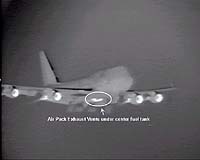
|
| ©Unknown |
| disclaimer: image is for illustration purposes only |
According to El-Op, the Multi Spectral Infrared Countermeasure system only weighs about 50 pounds but is capable of immediately responding to barrages of up to 1,000 missiles at once. This includes all kinds of missiles, not just the shoulder-launched variety, the company said in a statement.
The cost of the system is still classified, a spokeswoman told United Press International in a telephone interview.
"The system is effective against ground-to-air heat-seeking missiles," Andrew Lovett, El-Op's director of marketing and business development, EOCM Division, told UPI in a telephone interview.
MUSIC consists of two parts: a missile-approach warning and a signal-jamming system, Lovett said. "It detects a missile launch and issues a warning that a missile is coming (from a certain direction)," he said. Then, the laser "rotates to that direction and locates, acquires, and tracks it to jam the homing circuits and cause the missile to miss its target."
The technology is "a completely different concept" from the current systems in use in Israel, which are based on flares, Lovett said. In that system, a flare is launched from the plane as "a decoy target -- it appears as a hotter target," and the missile is lured off-course.
While the simplicity of flare technology can be an advantage, Lovett explained, the disadvantage is that the flares must be maintained and replaced, and that during false alarms, flares are still fired. However, a false alarm with the MUSIC system simply means that "a few photons were fired off into space."
News reports in Israel immediately following the announcement suggested that Israel Aerospace Industries-designed flare system could pose a fire hazard, a claim the company rejected.
In any case, "the world is moving toward laser (systems), not flares," Lovett told UPI. He cited recent American purchases of laser-based technology as an example, and said he has seen reports of new Man Portable Air Defense System missiles that are immune to flare defense.
The El-Op statement also said the United States favors technology such as that employed by the MUSIC system: "It's important to know that in the United States, several alternatives (to the current technology) were considered and the Department of Homeland Security came to the unequivocal conclusion that a laser-based solution is the only solution suited to deal with this kind of threat."
For Israel, the move to increase its systems for civilian missile defense is a logical one: al-Qaida attempted to strike an Israeli plane over Kenya in 2003. Furthermore, last year's war in Lebanon saw daily missile barrages on Israel, and this week the U.N. Security Council announced that Hezbollah, the guerrilla group with which Israel fought, has substantially increased its missile stores since then.
"The report states that, according to Israel, Hezbollah's long-range missile teams are deployed north of the river, and that 'most of the new missiles include (the Iranian-made) Zelzal and Fajr missiles that have a range of over 250 kilometers and are capable of hitting areas south of Tel Aviv,'" the Israeli daily newspaper Haaretz reported Wednesday.
Haaretz said: "The report added that Israel says Hezbollah has established an anti-aircraft unit armed with surface-to-air missiles."
However, the United States is unlikely to follow Israel's lead at this time, though the idea of putting missile defense systems on American airliners is not new. Terrorism expert Brian Michael Jenkins, who served on a presidential aviation security panel during the Clinton administration, told UPI in a telephone interview that there are several reasons for this -- chief among them the cost.
Jenkins, speaking from California, said that at roughly $1.25 million per plane, outfitting the United States' 6,000- to 7,000-plane fleet would be at no small cost. "If you do the math, that comes out to $10 billion," he said. When the cost of maintaining the systems over a 10-year period is factored in, that price tag would reach $40 billion, he added.
This kind of expense seems untenable, especially considering that most U.S. airlines have been delaying spending on such basics as new planes. "The nation's fleet of aircraft, on average, is aging right along with the passengers," The New York Times reported late last week.
"Northwest Airlines, for example, flies 109 of the oldest jetliners in the country, DC-9s, with an average age of 35 years. Northwest has yet to decide how to replace the DC-9s, which could remain in service another five years or more," the report said, adding that American Airlines also maintains a particularly old fleet.
"I suggested (outfitting) a number of planes flying internationally ... (as a way of) getting a baseline for the number of false alarms and so on," Jenkins, the former White House commissioner on aviation safety and security, told UPI. He said this could be a way to determine the risks of using the system in an urban environment and a way to "take a small step" toward implementing the technology.
However, he said, that idea was rejected. Now, a missile defense system for U.S. planes is "unlikely."
"Unless, heaven forbid, there is a major incident of a terrorist shooting down a commercial airliner ... outside of a conflict zone. Then, the pressure (to add missile defense) would increase enormously," he concluded.



Reader Comments
to our Newsletter